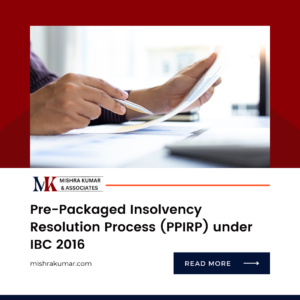Navigating the Insolvency and Bankruptcy Process as a Resolution Applicant
The Insolvency and Bankruptcy Code (IBC) in India provides a structured framework for the resolution of financial distress faced by corporate entities. Resolution applicants are individuals or entities interested in reviving financially distressed companies through the submission of resolution plans. In this blog, we will explore the insolvency and bankruptcy process for resolution applicants, emphasizing the importance of professional assistance in effectively participating in the process and submitting successful resolution plans.
INTRODUCTION
The Insolvency and Bankruptcy Code (IBC) in India provides a structured framework for the resolution of financial distress faced by corporate entities. Resolution applicants are individuals or entities interested in reviving financially distressed companies through the submission of resolution plans. In this blog, we will explore the insolvency and bankruptcy process for resolution applicants, emphasizing the importance of professional assistance in effectively participating in the process and submitting successful resolution plans.
ANALYSIS
Understanding the Insolvency and Bankruptcy Process for Resolution Applicants
Before discussing the role of professional assistance, let’s clarify what the insolvency and bankruptcy process for resolution applicants entails:
Resolution Applicant: A resolution applicant is an individual, entity, or consortium interested in submitting a resolution plan to revive a financially distressed corporate debtor.
Insolvency Resolution Process (IRP): The IRP is initiated when a corporate debtor defaults on its debt obligations. An insolvency professional is appointed as the IRP to manage the resolution process.
Committee of Creditors (CoC): The CoC, consisting of financial creditors, plays a central role in evaluating resolution plans and making key decisions.
Resolution Plan: Resolution applicants prepare and submit plans to revive the corporate debtor. These plans are evaluated by the CoC, which selects the most viable one.
Liquidation: If a resolution plan is not accepted or the IRP period expires without resolution, the company proceeds to liquidation. Liquidation involves the sale of assets to repay creditors.
Importance of Professional Assistance
Why is professional assistance crucial for resolution applicants in the insolvency and bankruptcy process?
Legal Expertise: The insolvency process involves complex legal provisions. Legal professionals guide resolution applicants through the process, ensuring compliance with regulations and protecting their legal rights.
Financial Assessment: Professionals assess the financial health of the corporate debtor, including evaluating assets, liabilities, and outstanding debts, which is critical for developing a viable resolution plan.
Negotiation Skills: Skilled negotiators represent resolution applicants during discussions with the Committee of Creditors or the corporate debtor, aiming to secure approval for their resolution plan.
Operational Support: Experts assist in developing and executing operational strategies outlined in the resolution plan, ensuring a smooth transition post-approval.
Compliance: Professionals ensure that resolution plans adhere to all legal and regulatory requirements.
Part 3: The Insolvency and Bankruptcy Assistance Process for Resolution Applicants
The assistance process for resolution applicants in insolvency and bankruptcy generally involves the following steps:
Legal Consultation: Legal experts provide guidance on the rights and obligations of resolution applicants under insolvency laws.
Financial Assessment: Professionals assess the financial condition of the corporate debtor and conduct due diligence, aiding in the development of a robust resolution plan.
Resolution Plan Development: Resolution applicants prepare and submit comprehensive resolution plans, detailing how they intend to revive the corporate debtor.
Negotiation and Presentation: Negotiations with the Committee of Creditors or the corporate debtor may occur, and resolution plans are presented for evaluation.
Compliance and Reporting: Professionals ensure that resolution plans adhere to all legal and regulatory requirements, including necessary disclosures and timelines.
CONCLUSION
The insolvency and bankruptcy process for resolution applicants is a complex and competitive arena. Professional assistance provides resolution applicants with the legal expertise, financial assessment, negotiation skills, operational support, and compliance guidance needed to effectively participate in the process and increase their chances of submitting successful resolution plans.
As India’s insolvency landscape continues to evolve, the role of professionals in assisting resolution applicants remains pivotal in achieving successful resolutions that benefit all stakeholders involved.
FAQs
Q1: What happens if a resolution plan submitted by a resolution applicant is not accepted by the Committee of Creditors (CoC)?
A1: If a resolution plan is not accepted by the CoC, the corporate debtor may proceed to liquidation. The resolution applicant’s plan must secure the required approval from the CoC to be implemented.
Q2: Can a resolution applicant participate in multiple insolvency processes simultaneously?
A2: Yes, resolution applicants can participate in multiple insolvency processes simultaneously, subject to certain conditions and limitations as per the IBC and regulations.
Q3: Is professional assistance mandatory for resolution applicants in the insolvency process?
A3: Professional assistance is not mandatory but is highly recommended due to the complexity of the insolvency process. Professionals can provide valuable guidance and expertise to increase the likelihood of submitting a successful resolution plan.
RECENT POSTS
- The implication of Stamp Duty on Scheme of Arrangement (Merger & Amalgamation):
- Pre-Packaged Insolvency Resolution Process (PPIRP) under IBC 2016
- BUY BACK OF SHARES V/S DIVIDEND
- Comprehensive comparative analysis of SEBI (Listing Obligations and Disclosure Requirements) (Second Amendment) Regulations, 2021.
- SEBI (Delisting of Equity Shares) Regulations, 2021-Imposes new responsibilities on the board of directors.

The implication of Stamp Duty on Scheme of Arrangement (Merger & Amalgamation):
The implication of Stamp Duty on Scheme of Arrangement (Merger & Amalgamation): The Scheme of Arrangement is a legal mechanism under corporate law that allows

Pre-Packaged Insolvency Resolution Process (PPIRP) under IBC 2016
Pre-Packaged Insolvency Resolution Process (PPIRP) under IBC 2016 The Insolvency and Bankruptcy Code (IBC) 2016, is a comprehensive legislation aimed at consolidating and amending laws

BUY BACK OF SHARES V/S DIVIDEND
BUY-BACK OF SHARES V/S DIVIDEND A dividend offers cash rewards to all shareholders in accordance with their stake in the company, whereas a share buyback

Comprehensive comparative analysis of SEBI (Listing Obligations and Disclosure Requirements) (Second Amendment) Regulations, 2021.
Comprehensive comparative analysis of SEBI (Listing Obligations and Disclosure Requirements) (Second Amendment) Regulations, 2021. Securities and Exchange Board of India (“SEBI”) vide notification dated May

SEBI (Delisting of Equity Shares) Regulations, 2021-Imposes new responsibilities on the board of directors.
SEBI (Delisting of Equity Shares) Regulations, 2021-Imposes new responsibilities on the board of directors. Securities and Exchange Board of India (“SEBI”) vide notification dated 10th

Summary of Insolvency and Bankruptcy Board of India (Liquidation Process) (Amendment) Regulations, 2024
Summary of Insolvency and Bankruptcy Board of India (Liquidation Process) (Amendment) Regulations, 2024 The Insolvency and Bankruptcy Board of India (IBBI) recently issued amendments to

